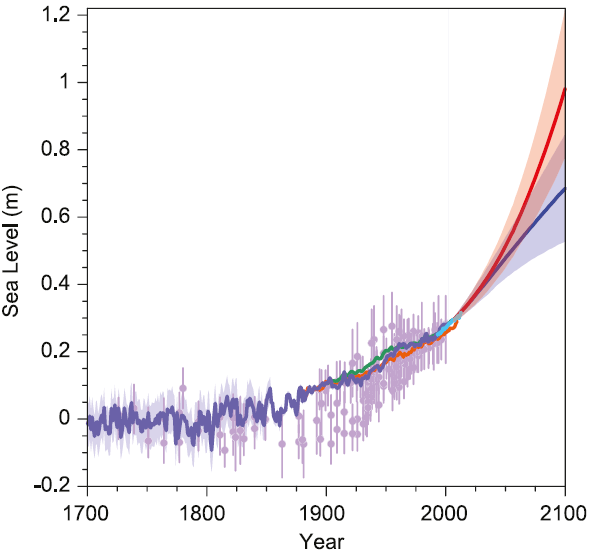
Misleading : The rate of sea level rise is expected to increase as a result of ocean warming and melting glacial ice, so using the current rate to project the future risk of storm surge fails to account for what the risk really is.

REVIEW
CLAIM: Sea level rise, which was occurring long before humans could be blamed, has not accelerated and still amounts to only 1 inch every ten years. If a major hurricane is approaching with a predicted storm surge of 10-14 feet, are you really going to worry about a sea level rise of 1 inch per decade?
Benjamin Horton, Professor, Earth Observatory of Singapore:
Proxy analysis has clearly shown an acceleration in rate of sea-level rise. Our research* found that the rate of sea-level rise on the US Atlantic coast is greater now than at any time in the past 2,000 years. The research also shows a consistent link between global mean surface temperature and changes in sea level for the past millennium. The study shows that after relatively subtle changes in temperature and sea-level rise over the last 2,000 years, the rate of sea-level rise increased in the late 19th century.
Sea-level rise contributes significantly to the frequency of flooding from hurricanes. The contribution from sea-level rise to flood height works in together with other factors such as timing of the storm relative to high tide, and the strength and direction of individual hurricanes. Sea-level rise between hurricanes raises the “baseline” water level and makes flooding more likely. We published another paper* showing that New York City can expect nine-foot floods, as intense as that produced by 2012’s Superstorm Sandy, at least four times more frequently over the next century. We report that floods as intense as Sandy’s would have occurred about once every 400 years on average under present day sea-level rise conditions, but that over the 21st century are expected to be about four times more probable (once every 100 years) due to an acceleration in the rate of sea-level rise.
- Kemp et al. (2011) Climate related sea-level variations over the past two millennia, Proceedings of the National Academy of Sciences
- Lin et al. (2016) Hurricane Sandy’s flood frequency increasing from year 1800 to 2100, Proceedings of the National Academy of Sciences
Peter Gleick, President Emeritus and Chief Scientist, Pacific Institute:
A major storm that has a sea-level higher than it would otherwise have been without climate change will simply be more damaging. It doesn’t matter that current sea-level rise changes are slow. Sandy’s storm surge hit at high tide—a tide that was higher than it would otherwise have been because of human-caused climate change. Some estimates are that damages were many billions of dollars higher as a result.
Kerry Emanuel, Professor Emeritus of Atmospheric Science, MIT:
Sea level rise is indeed accelerating and is currently tracking predictions that are consistent with a roughly 1 meter (3 foot) rise by the end of the century. We are already seeing bad effects in places like Miami Beach. And 1 meter makes a large difference, so if one is concerned about one’s descendants, then yes, it is something to worry about.
Jim Kossin, Distinguished Science Advisor, First Street:
Sea level rise and its impacts vary considerably by region. To state a global mean number is misleading and irrelevant to those regions that are most vulnerable. With or without hurricanes added to the mix, the impacts on humans from sea level rise can be seen now. The author’s comparison of hurricane storm surge to sea level rise is very misleading and blurs the relevance of sea level rise to humans. Sea level rise is creating nuisance flooding in a number of places. The fact that hurricane storm surge is bigger is irrelevant and does not change the fact that people are being impacted.
Victor Venema, Scientist, University of Bonn, Germany:
Sea level rise started before we had good instrumental observations, which makes it harder to see the acceleration. If you look sea level rise for longer periods based on indirect (proxy) evidence, it is clear that the current sea level rise is much faster than it was during the last 1000 years.
See for example this article on RealClimate on a recent study for the last 2000 years.

It will depend on our actions whether sea level rise will accelerate much more. See this article on the expected sea level rise for the coming century.
Figure – Past and future sea-level rise. For the past, proxy data are shown in light purple and tide gauge data in blue. For the future, the IPCC projections for very high emissions (red, RCP8.5 scenario) and very low emissions (blue, RCP2.6 scenario) are shown. Source: IPCC AR5 Fig. 13.27





